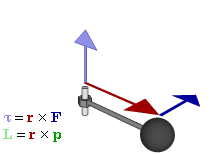"Somebody for the love of god explain to me how that works, how the fuck does that happen?"
- Bill Burr
Sure! I heard Bill bring this up on the Joe Rogan podcast, and since my intended next post is becoming more long winded than I hoped, I thought this would make for a nice subject.
Let's start with Newton's first law: objects in motion tend to stay in motion, and objects at rest tend to stay at rest, unless acted upon by some outside force (force is an important word here). This concept is at the core of inertia, the resistance an object has to change in it's behavior. There is a basic kind of inertia in reference to motion, with mass being the basic measure of an object's resistance. But there is also a rotational inertia, based on both the mass and the shape of the object, along with defining exactly which axis you are rotating the object around.
Once you start an object a'spinning, the combination of the angular speed and the rotational inertia defines the angular momentum. In the case of a wheel-shaped object spinning as the one in the video, this momentum can be imagined as an arrow pointing out from the axle (I know it's odd to imagine that the angular momentum is directed perpendicular to the actual rotation, but just trust me that it works out mathematically).
 |
| L is the angular momentum. Torque (T) is the applied force. (wiki) |
By Newton's law, we know that this angular momentum, pointing outward, will resist any disturbances in it's speed or direction. And thus, so long as it is spinning fast enough (increasing the value of L), the wheel resists being pulled downward by gravity - indeed, tries to resist tilt of any kind. That outward arrow remains as constant as possible. This is exactly why it's easier to maintain balance on a bike when you're moving faster - below a certain speed, the angular momentum is overwhelmed by the forces of gravity. Likewise, a top, or that wheel above, as they slowed, would begin to fall as their resistance to a downward pull weakens.
As gravity is a force, it is being applied perpetually, pulling and pulling ever downward. So, if you imagine the upward (rope) arrow staying constant, and the outward arrow of momentum trying to stay constant, the ever-pulling grip of gravity must somehow be answered, which the wheel does by slowly twirling around the rope, in a horizontal redirection of the downward force.
Hope that wasn't too difficult of a read. To technically understand the rotation of three dimensional bodies is surprisingly unintuitive.
"Science is like, it's incredible, isn't it?"
- Bill

That gyro force is tough to wrap your brain around. I read a paper last year that stated the gyro force created by motorycle wheels was over-rated for stability. As a long time biker I immediately recognized it as bad science.
ReplyDeleteFor years I have advised novices to avoid scooters, get a motorcycle, the tires on scooters are too small to provide stability and they will slam down in a heartbeat. More people on scooters get car-slammed than bikers.
I have an old Triumph with a 19" front wheel and it will lean over to 15 degrees without sliding even at lower speeds.
It was very refreshing to hear an actual science guy on JR for a change. I was disappointed that Joe seemed to get lost and characterized some of your explanations as sort of 'eye glazing' He was wrong. You did a great job and it was fascinating, I definitely picked up some new knowledge and you helped fill in some blanks on Quantum Theory for me.
I watched all those old Feynman lectures and have a very tenuous grasp on the subject. I'm a layman and mathematical illiterate but I was able to follow you, you did a great job, bro and also:
REPRESENTIN for Houston!! Loved it.
Glad I found your blog. Bookmarked.
-Scooter
http://acksisofevil.org/innerside.html
http://skeptiles.com
Angular momentum ... which if I remember correctly doesn't even exist ... was always a pain in the ass. ;)
ReplyDelete